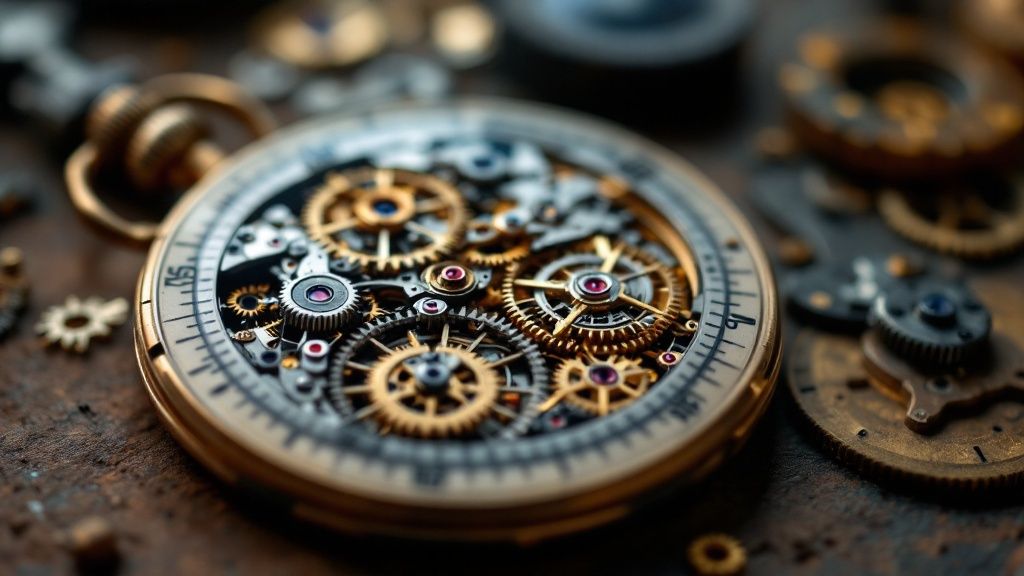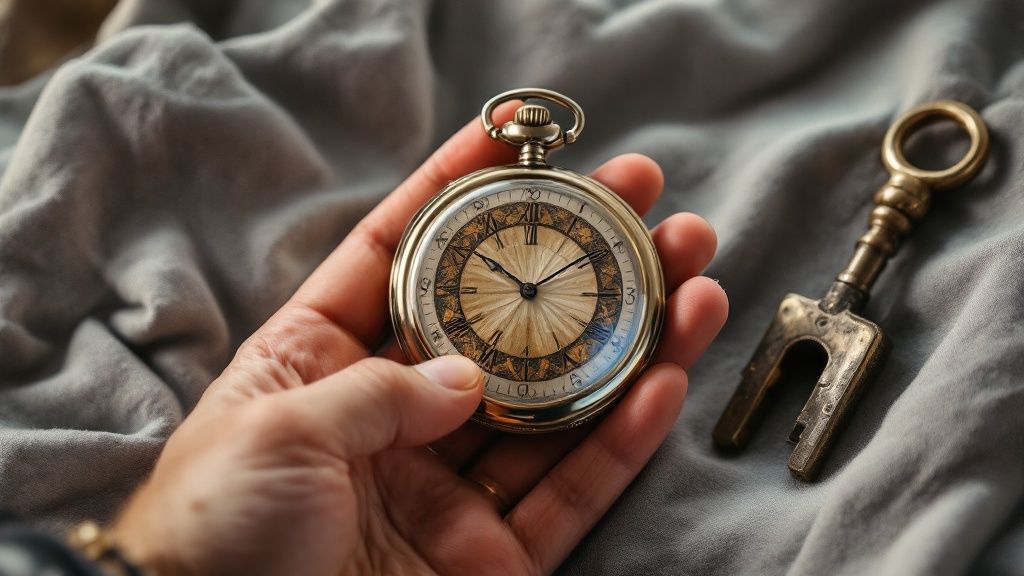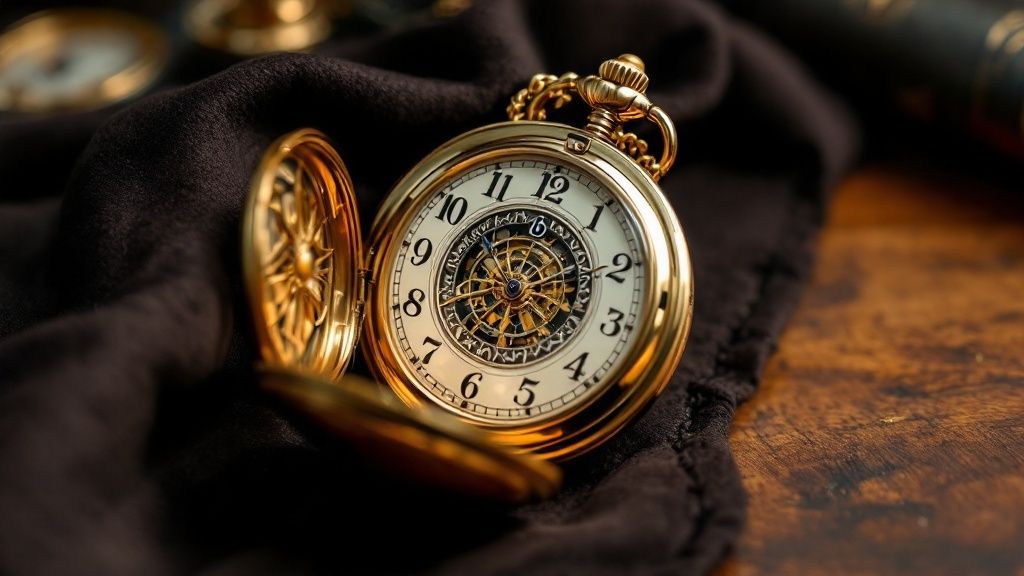The Fascinating Evolution of Bulls Eye Pocket Watches

The bulls eye pocket watch, with its distinctive dial, is more than a simple time-telling device. It offers a glimpse into British history, reflecting societal shifts in technology, fashion, and even politics. This journey, from a practical tool to a prized collectible, is what makes the bulls eye pocket watch so captivating.
From Function to Fashion: The Rise of the Bulls Eye Dial
Early pocket watches prioritized function. Their primary purpose was accurate timekeeping. As British watchmaking skills developed, however, a desire for aesthetically pleasing designs emerged. The bulls eye dial, featuring concentric circles resembling a target, became a popular stylistic choice.
This design enhanced visual appeal and improved readability. Telling time at a glance became significantly easier. This shift marked a crucial point in the pocket watch's evolution, transforming it from a simple instrument into a fashionable accessory.
The Impact of British Horological History
The bulls eye pocket watch's rise coincided with a golden age of British watchmaking. In the 18th century, Britain led the world, producing half of all watches. Many of these were pocket watches, showcasing the nation's horological expertise.
Innovations like the cylinder escapement and the detent escapement further advanced British watchmaking. Learn more about the history of British watchmaking. The 19th century, however, brought new challenges, with mass production in the U.S. undercutting British manufacturers. Despite this, British pocket watches, especially the bulls eye, retained their reputation for intricate craftsmanship and precision.
Materials and Mechanisms: Markers of an Era
The evolution of the bulls eye pocket watch is evident in its materials and mechanisms. Early models often used precious metals like gold and silver, reflecting the owner's status. As technology progressed and tastes changed, materials like steel and base metals became more common.
Proper care is crucial for preserving these timepieces. An Office Equipment Maintenance Checklist can provide general maintenance tips adaptable to pocket watch care. Internal mechanisms also evolved. Improvements in escapements and balance wheels enhanced accuracy and dependability.
These technical advancements, along with shifting styles, provide clues for collectors. By examining a bulls eye pocket watch closely, we appreciate the skill of British watchmakers. We also gain insight into the fascinating era in which they worked.
Unmistakable Hallmarks of Authentic Bulls Eye Watches
Bulls eye pocket watches, prized for their intricate craftsmanship and historical significance, hold a special place among collectors in the UK. Distinguishing genuine articles from reproductions requires a keen eye for detail and an understanding of key features. These hallmarks, from the distinctive dial to the case material, play a crucial role in determining a watch's authenticity and, ultimately, its value.
The Defining Bulls Eye Dial
The defining feature of a bull's eye pocket watch is, of course, the bulls eye dial. Characterized by concentric circles resembling a target, this design element is more than just decorative. In the pre-digital era, these rings, often textured or featuring contrasting colors, made quick time-telling much easier. The earliest dials often featured enamel, while later examples incorporated painted or printed designs.
Case Materials: From Precious to Practical
The case material provides valuable insights into a bull's eye watch’s authenticity and period. Early examples often featured precious metals like gold or silver, reflecting the status of the owner. As these pocket watches became more accessible, more affordable materials like brass and steel came into use. While less luxurious, base metals allowed for intricate case designs and showcased the artistry of British watchmakers.
Let's explore the key features that distinguish authentic Bulls Eye pocket watches across different eras in the table below:
Bulls Eye Pocket Watch Identifying Features
Key characteristics to identify authentic Bulls Eye pocket watches across different eras
| Feature | Early Period (1750-1800) | Middle Period (1800-1850) | Late Period (1850-1900) |
|---|---|---|---|
| Case Material | Primarily gold or silver | Gold, silver, and introduction of brass | Brass, steel, and some precious metals |
| Dial | Enamel dials common | Enamel and painted dials | Painted, printed, and some enamel dials |
| Movement | Verge fusee escapements prevalent | Transition to lever escapements | Lever escapements become standard |
| Decoration | Simple, elegant designs | Increasingly ornate cases | Engine-turned and engraved cases |
This table summarizes some of the typical characteristics found in Bulls Eye watches from different periods. These details can assist collectors in accurately dating and authenticating their timepieces.
The following infographic further illustrates the evolution of bull's eye pocket watches:
Modern materials and manufacturing have resulted in lighter and significantly more accurate timepieces. This ongoing refinement of watchmaking, even for a traditional design like the bull's eye, is a testament to horological innovation.
Movement and Mechanical Signatures
Beyond the exterior, the movement of a bull's eye pocket watch offers critical clues to its authenticity. A qualified watchmaker should examine the movement, which requires opening the case. Authentic pieces will have a mechanical, manual-wind movement. The movement’s finish, markings, engravings, and even the type of escapement can help determine the maker and age. Some watches even have stamped model numbers, a boon for collectors. This attention to internal mechanisms underscores the importance of precision engineering in British watchmaking history. These subtleties contribute to the enduring appeal of the bull's eye pocket watch among collectors.
Beyond Timekeeping: The Social Power of Bulls Eye Watches

In 18th and 19th century Britain, the bulls eye pocket watch was more than a simple timekeeping device. It served as a powerful symbol of social standing, subtly conveying wealth, taste, and social connections. These elegant timepieces played a key role in the social dynamics of the era, imbuing everyday interactions with deeper meaning.
Status Symbols and Social Currency
Owning a bulls eye pocket watch, especially one crafted from precious metals like gold or silver, was a clear indication of prosperity. Similar to a luxury car today, a finely made timepiece signaled success and financial stability. But the social influence of the bulls eye pocket watch went beyond mere displays of wealth.
Specific models and styles were associated with particular social classes. This allowed individuals to subtly communicate their social position through their choice of watch. This intricate, unspoken communication reinforced social hierarchies and played a significant role in navigating the complex social structures of the time.
Displaying and Discussing Bulls Eye Watches
The way bulls eye pocket watches were displayed and discussed further emphasized their social significance. A prominent display, perhaps casually hanging from a waistcoat pocket, provided a glimpse into an individual's taste and affluence. Conversations about the watch's maker, its intricate mechanisms, or unique features offered opportunities to build rapport and establish social connections.
The gifting and inheritance of these timepieces also carried considerable weight. Presenting a bulls eye pocket watch as a gift symbolized deep respect and affection, strengthening social bonds. Inheriting a watch connected future generations to family history and legacy, adding a personal dimension to the object's value. This tradition demonstrated the enduring significance of these watches, far exceeding their monetary worth.
The Rise and Fall of British Watchmaking
The evolution of pocket watches in the UK reflects broader social and economic changes. As early as the 16th century, pocket watches became common among the upper classes as symbols of status and wealth. Materials like brass, gold, and silver underscored this luxury appeal. Innovations like the addition of the minute hand increased the accuracy and functionality of these timepieces. However, the British watchmaking industry eventually faced challenges from international competition, particularly from the U.S. after the mid-19th century. Explore this topic further. This competition contributed to a decline in the domestic production of high-quality pocket watches, providing additional historical context to the bulls eye pocket watch’s journey. Collecting these watches today connects us to a rich and compelling past. It’s not simply about owning a beautiful item; it's about engaging with a fascinating piece of history.
Building Your Collection: Insider Strategies That Work
The world of Bulls Eye pocket watch collecting can seem overwhelming at first. But with a few smart strategies, you can build a meaningful collection you’ll truly treasure. This section offers expert advice, gathered from seasoned collectors and UK experts, to guide you in acquiring these horological gems.
Authentication: Beyond the Surface
Experienced collectors understand that authentication involves more than just a quick look. While the bulls eye dial is the key feature, understanding the nuances of case materials, movement markings, and overall quality is essential. For instance, early Bulls Eye pocket watches often sported gold or silver cases, while later examples may be brass or steel. This change often reflects economic shifts and evolving tastes. Inspecting the movement for stamped serial numbers or production dates, a practice particularly valuable with Westclox Bull’s Eye models post-1960s, can provide important clues.
Sourcing Your Treasures: Where the Experts Look
Knowing where to find these watches is half the battle. Online auctions like eBay are a good starting point. However, don't overlook the charm of antique shops and fairs across the UK. These venues offer the chance to handle watches in person and connect with knowledgeable dealers. Joining specialized collector groups or online forums can also open doors to private sales and provide a heads-up about upcoming auctions. Connecting with experienced collectors can greatly deepen your market knowledge and help you spot undervalued treasures.
Price Expectations and Condition Issues
Realistic price expectations are vital for successful collecting. A bull's eye pocket watch's value depends on factors like its age, maker, condition, and provenance. Even small imperfections, like a hairline crack on the enamel dial or a slightly bent hand, can significantly affect the price. Thorough research and careful inspection are essential before purchasing.
To help you understand the key factors determining value, we’ve created a helpful table:
Here’s a quick guide to the various factors affecting a Bulls Eye pocket watch's value:
Bulls Eye Pocket Watch Value Factors
Key elements that determine the market value of Bulls Eye pocket watches
| Factor | Low Value Indicators | Medium Value Indicators | High Value Indicators |
|---|---|---|---|
| Condition | Heavy wear, significant damage, non-working movement | Minor wear, some scratches, working movement | Excellent condition, minimal wear, fully functional |
| Maker | Mass-produced model, unknown maker | Reputable maker, mid-range model | Prestigious maker, rare model |
| Provenance | No documentation, unknown history | Some documentation, known previous owner | Extensive documentation, notable previous owner |
| Rarity | Common model, readily available | Less common model, moderately available | Rare model, difficult to find |
As you can see, condition and maker are major factors influencing a watch’s value, alongside its history and how rare it is.
Investment Potential vs. Historical Significance
Finally, consider your collecting goals. Are you focused on investment potential, or are you drawn to the historical significance of these timepieces? Some rare Bulls Eye pocket watches can significantly appreciate in value. Others hold more historical than monetary worth. Understanding this difference will shape your collecting strategy. By focusing on watches from particular eras, makers, or those with documented provenance, you can build a collection that aligns with your personal interests and investment objectives.
British Watchmaking's Golden Age: Production Insights

The bulls eye pocket watch, a symbol of British horological ingenuity, epitomized a period of exceptional craftsmanship. This era, spanning the late 18th and 19th centuries, fostered a thriving network of specialists. From toolmakers crafting precision instruments to dial enamellers adding artistic flourishes and case engravers personalizing each timepiece, a collective of artisans contributed to the creation of each watch.
This intricate process resulted in timepieces that were not merely functional, but also works of art.
The Apprenticeship System: A Foundation of Excellence
This remarkable quality was maintained through a demanding apprenticeship system. Young watchmakers dedicated years to honing their skills under the guidance of seasoned masters.
This rigorous training ensured the preservation of time-honored techniques and instilled a deep respect for precision. Apprentices mastered a wide range of skills, from the delicate art of crafting balance springs to the precise assembly of intricate gear trains. This commitment to excellence made British watches highly sought after internationally.
Trading Networks: Reaching a Global Audience
The distribution of bulls eye pocket watches and other timepieces relied on vast trading networks that spanned the globe. British merchants cultivated relationships with markets in Europe, Asia, and the Americas.
This global reach demonstrated the high demand for British-made watches. It also disseminated British horological expertise worldwide. Interestingly, the principles of global trade resonate even in modern business contexts. If you're interested in expanding your business portfolio, consider learning about the complexities of buying a business.
Production Statistics: A Glimpse into the Industry's Scale
The British watchmaking industry peaked in the late 18th century. In 1796, the number of watches hallmarked at Goldsmiths' Hall in London reached an impressive 191,678.
This figure, encompassing both gold and silver watches, including pocket watches, illustrates the industry's scale. This period represented the pinnacle of British watchmaking. However, the industry would later face new challenges. You can delve deeper into British watchmaking statistics to gain a more comprehensive understanding of the industry's trajectory.
Technological Innovations: Driving Evolution
British watchmakers continually pushed the boundaries of horology through constant innovation. Each generation contributed advancements to escapement mechanisms, balance wheels, and other crucial components.
These improvements enhanced accuracy, reliability, and overall performance. For example, the development of the lever escapement, which replaced the earlier verge fusee escapement, significantly improved timekeeping precision. This pursuit of technical excellence was a driving force in the evolution of the bulls eye pocket watch.
Economic Shifts: Transforming Production
Evolving economic conditions, especially in the late 19th century, influenced production methods. The growth of mass production in other nations, particularly the United States, presented formidable competition.
This prompted the British watchmaking industry to adapt, focusing on specialized, high-end timepieces. This era witnessed the emergence of novel materials and designs. The continued evolution of the bulls eye pocket watch demonstrates the adaptability and resilience of British watchmaking. This historical perspective adds depth and significance to the watches cherished by collectors today.
Preserving Your Horological Heritage: Care Essentials
A bull's eye pocket watch, particularly one with UK origins, represents more than just a timepiece. It embodies a piece of horological heritage. Often passed down through families, these mechanical marvels require special attention to ensure they continue ticking for generations to come. This involves understanding both their intricate workings and how to best preserve their unique character.
Handling Your Bull's Eye Pocket Watch: A Gentle Approach
The first step in preservation is proper handling. Always hold the watch over a soft surface, like a padded watch cushion or a microfibre cloth, to prevent damage from accidental drops. Avoid directly touching the dial or the movement. Over time, fingerprints can corrode these delicate surfaces and potentially obscure intricate details. When winding your bull's eye pocket watch, use gentle, smooth motions. Jerky winding can strain the mainspring, a common problem in older timepieces. This careful approach protects the watch's mechanics and ensures long-term functionality.
Storing Your Pocket Watch: Protecting From the Elements
Proper storage is crucial, especially given the unpredictable UK climate. Ideally, store your watch in a dry, stable location away from direct sunlight and temperature extremes. A dedicated watch box lined with anti-tarnish cloth offers excellent protection. Alternatively, a small, airtight container placed inside a drawer can also be effective. For added protection against humidity, include silica gel packets inside the storage container. These packets absorb excess moisture, safeguarding the watch from rust and other environmental damage.
Professional Servicing: Balancing Authenticity and Functionality
Regular care is essential, but professional servicing may sometimes be necessary. Choose a watchmaker specializing in antique pocket watches. The intricate movements, especially in earlier models with verge fusee escapements, demand expert handling. For example, attempting to service a Westclox Bull’s Eye model, often riveted rather than screwed together, could easily lead to irreversible damage if not handled correctly. Discuss your watch's historical significance with the watchmaker. A knowledgeable professional understands the ethical implications of restoration and prioritizes preserving historical integrity while ensuring the watch remains functional.
Documenting and Insuring Your Collection
Beyond physical care, documenting your bull's eye pocket watch's history is essential. Maintain records of its purchase, any repairs, and its background if known. This documentation not only enriches the watch's story but also proves crucial for insurance purposes. Speaking of insurance, ensure your collection has adequate coverage. Specialized insurance for collectibles typically provides superior protection compared to standard home insurance. Photograph your watch from various angles, documenting any unique features or hallmarks. These photos become invaluable if the watch is ever lost or stolen. This proactive approach protects your investment and provides peace of mind.
Looking to add to your collection? Explore our curated selection at Feinheit FZ LLC. We offer free global shipping and a special discount for new subscribers. Use code LUXE5 or WELCOME10 at checkout.
Discover more from theFeinheit
Subscribe to get the latest posts sent to your email.

